Snow Tales: Too Little, Too Late, Say Climate Experts
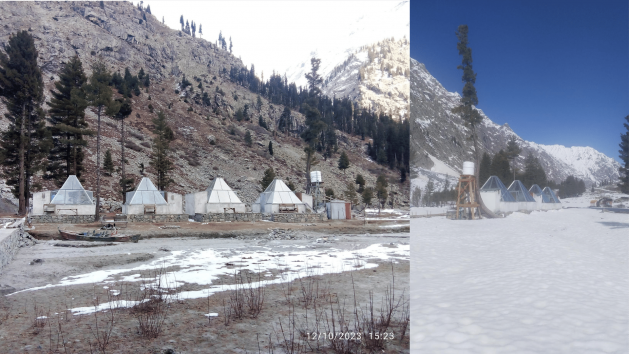
KARACHI, Jan 29 (IPS) - Whether the late snow in Pakistan’s Gilgit-Baltistan region is an anomaly or an indication of the impacts of climate change, which brings erratic and at times devastating weather patterns, experts in the region believe not enough is being invested in the development of capacities, systems, and infrastructure to improve resilience.
Alpine skier, 28-year-old Muhammad Karim, has spent the winter with his eyes skyward, wishing and hoping for deep and abundant snow.
“My bread and butter depend on the snow,” said the Olympian, who is also a ski trainer, at Naltar Ski Resort, in the valley by the same name nestled in the Gilgit-Baltistan’s Karakoram mountain range.
Heading the ice-hockey and alpine skiing section run by the Ski Federation of Pakistan and with the national skiing competition looming just weeks away (held between February 14 and 20 in Naltar), Karim had been getting sleepless nights as it had not snowed after a slight sprinkling of “half an inch” in November, and there were chances the sporting event would be called off.
But as predicted by the Meteorological Department, the snowfall began on January 28 and “will continue for a few days,” said Karachi-based Dr. Sardar Sarfaraz, chief meteorologist at the Pakistan Meteorological Department.
But it's not yet good news.
“It’s too light,” said Karim, talking to IPS over the phone from Naltar. “We are still uncertain about the event,” he added.
Without prolonged cold winter days to follow the snowfall, the snow will melt away, said Sarfaraz, continuing: “Nor will it compensate for the almost 80–90 percent less precipitation the country faced in December and January.”

“It is too little, too late,” said Sher Mohammad, a cryosphere expert at the Nepal-based International Centre for Integrated Mountain Development (ICIMOD), over an email exchange.
This year has been quite unusual. It has been an almost snowless winter in the northern region of the Himalayan-Hindukush-Karakoram ranges.
“We usually experience the first snowfall by the end of October in some parts of G-B, and this continues well into March,” said Shehzad Shigri, director of the Gilgit-Baltistan Environmental Protection Agency, speaking to IPS from Gilgit city.
“Winter has been milder,” he said, due to the El Niño effect. The temperatures recorded by the seven weather stations, however, show “an increase by 0.5 degree Centigrade in the region, on average, since 1983, and a decrease of precipitation (rain and snow) by 8.4 mm,” said Shigri.
Arun Bhakta Shrestha, senior climate expert at ICIMOD, underscoring the impact of global warming, explained the “unusual absence of snowfall in the Himalayas, Hindu Kush, and Karakoram this winter, attributing it to “warmer temperatures and fewer cold days and nights."
“Overall, in Pakistan, nights are getting warmer by 0.5°C, which means we are experiencing, on average, eight to ten fewer cold days,” corroborated Sarfaraz.
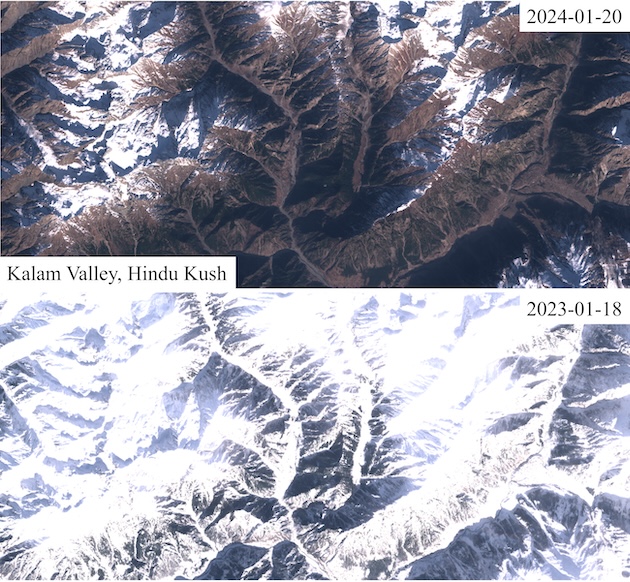
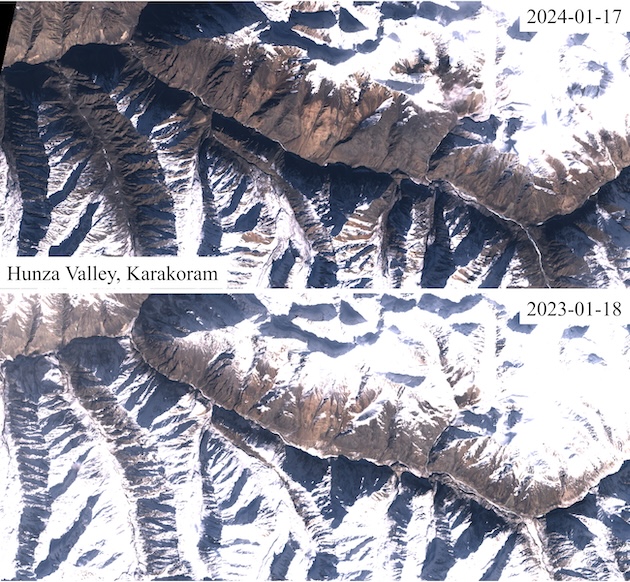
“This weather anomaly disrupts normal climate patterns, influenced by extreme La Niña-El Niño conditions and alterations to the Western Disturbance . These shifts, emblematic of the climate crisis, pose a significant threat to mountain communities and water security in the HinduKush-Himalayan region,” warned Shrestha.
But Sarfaraz is adamant El Niño is not to blame for less than average rain.
“Less precipitation in winter isn't due to El Niño, as it affects the summer and the monsoon rains,” he insisted, saying rains in winter, in Pakistan, are known to have a linkage with the North Atlantic Oscillation, which, “if positive, brings a good amount of rain, and when negative, brings less."
It is also premature to attribute a one-off snowless winter to 'climate change,' as it is not proven scientifically, he added.
Last year, 2023, according to climate scientists, with average temperatures of 1.34–1.54°C, was the hottest year since 1850–1900—the so-called pre-industrial era. Many scientists predict that 2024 could be hotter.
Whether anthropogenic or natural, a change in the fragile mountain ecosystem can have far-reaching consequences for the communities compared to terrestrial ones, Shigri said.
If nights are sleepless, the days have not been any easier for skier Karim. “I spend the day getting weather updates and rescheduling our plans. In between, he said, he is bombarded with phone calls from anxious athletes from all over Pakistan asking whether the event will be held at all.
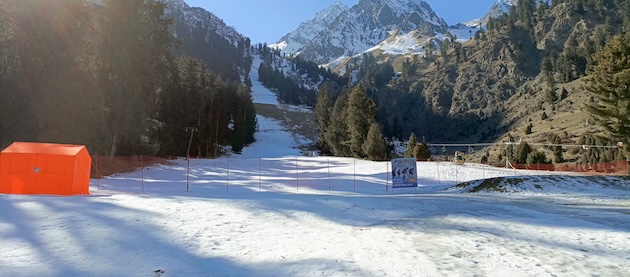
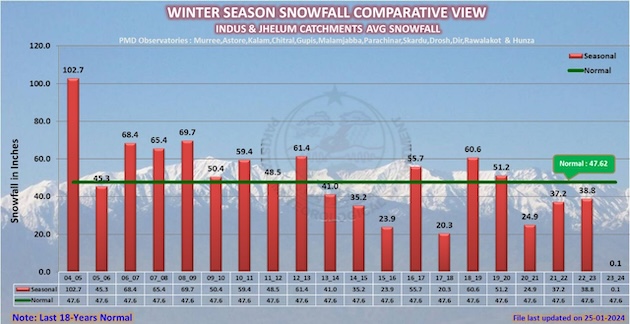
As a backup, the foundation had started making artificial snow. “We had managed to cover 20 percent of the Wildboar slope, where the competition is to be held, but another 30 percent needs to be covered before February 13,” said the trainer. Artificial snow is not only a costly venture; Karim said it also requires a certain temperature, without which the snow will melt. Having glided down natural snow since he was four, he was not too enthused about the imitation.
“You cannot slide as smoothly as you can on natural snow,” he explained.
But Karim is not the only one whose life depends on snow.
Like in Naltar, the bare slope in the ski resort of Malam Jabba, in KP’s Swat district, was being covered with artificial snow to generate some economic activity before it started snowing on the eve of January 27.
“The season has been pretty lean,” admitted Afkaar Hussain, spokesperson of the Malam Jabba Ski Resort. From catering to up to 3,500 customers per day last year, the number has come down to as many as 500 per day, with most arriving over weekends this year.
Hussain said people come from all over Pakistan, sometimes even for the weekend or just a day trip if they are close by, to enjoy snowfall, do skiing, snowboarding, ziplining, or just go up to the hotel at the top of the slope on a chairlift to capture the splendid snow-capped views.
“Last year this place was buzzing; I didn’t know when the day started and ended; this year I have been quite free, but I hope this bout of snow will bring tourists back to town, even though it’s a bit late and the holiday season is over in the plains,” he said.
Kalam, in the Swat Valley, in the Khyber Pakhtunkhwa province, where the first snow falls by mid-November and continues well into March, with snow up to eight feet, also got its share of snow on January 27.
“BBQ, endless cups of tea, and enjoying live music around a bonfire is a common sight in Kalam in the winter season,” recalled 30-year-old Noorulhuda Shaheen, adding that the flux of visitors was such that hotel rooms were booked months in advance—back in the day.
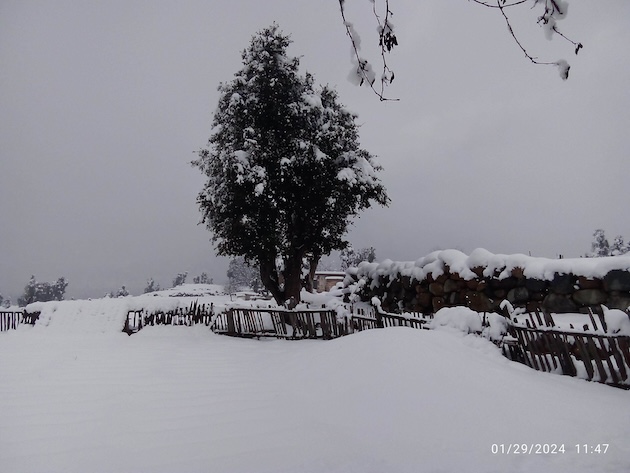
Seeing what a roaring business this could be, he decided to open four luxury tented huts (where those with an adventurous streak do ‘glamping’) on the camping site of the famous Mahodand Lake, about an hour and a half jeep-drive from Kalam, in 2022.
“I did great when the spring started, but then in August, the floods dealt a death blow to tourism. Last year there was a good four feet of snow, but due to the county’s economic situation, business did not pick up. This winter season (starting from November 2023–March 2024), I was hoping I’d do well,” said Shaheen.
But till last week, with Kalam giving a deadpan look, it seemed highly unlikely people would go up to Mahodand Lake for glamping. However, he is hopeful about the late arrival of snow.
He hopes that once the snow stops falling and the sun comes out, people will flock to the valley.
“My huts are well equipped to keep tourists warm; it’s just magical out there right now,” he said after visiting the place after the snowfall.
But it is not just a lack of tourists that is worrisome.
The mountain people depend on natural resources for their livelihoods and practice small-scale agriculture. The impact of an almost snowless winter can be devastating for his people, said Shaheen. “It will mean our springs will dry up when the entire population is pastoral and dependent on subsistence farming and rearing livestock.”
A recent blog on ICIMOD’s website explains it best: “Snow cover usually acts as an insulating blanket, shielding dormant crops, allowing root growth, preventing frost penetration, and protecting soil from erosion. Reduced snowfall and erratic rains across the Himalayan region have the potential to cause adverse ecological impacts in the region, including on water and agroforestry.”
But if temperatures rise, which may well happen, as pointed out by Shigri, this late snowfall will be even more problematic. “It will lead to flash flooding and GLOFs (glacial lake outburst flooding) sweeping away homes, orchards, and livestock,” he said.
If this becomes the norm, repeated absences of snowfall may accelerate the receding of glaciers, said Islamabad-based climate change and sustainable development expert Ali Tauqeer Sheikh. “It’s also possible that instead of less water downstream, there could be much larger quantities if there are heat waves in the upper Indus basin. This may cause more early (than historical patterns) and irregular water flows,” he said.
While experts may dither over a sure-shot explanation for the current no-show/very little snow episode, Islamabad-based climate expert Imran Khalid, working with WWF-Pakistan, said these episodes with “either too little or too much precipitation” will continue to be experienced due to global warming.
“Therefore, plans and policies need to be in place to tackle such extreme scenarios. These should entail enhancing the capacity of local communities to plan as well as utilizing instruments such as insurance mechanisms for an effective response,” he said.
“We should brace for the impacts,” agreed Vaqar Zakaria, the head of Hagler Bailly Pakistan, an environmental consultancy firm based in Islamabad, but rued: “We are not investing in the development of capacities, systems, and infrastructure to improve resilience; less water for crops, pastures, and micro- and even larger hydropower plants is what I would worry about most.”
And, added Sheikh, “Instead of raising alarm bells, we need to study the trends more closely and over longer periods of time rather than one or two seasons only.”.
Still, there are others who say Pakistan, not a major emitter but in the eye of a climate storm, could make a strong case for accessing the Loss and Damage Fund.
“The mechanisms for disbursement of funds (what little is available) are still in their infancy and, as such, cannot be relied upon to address the immediate needs of the communities,” said Khalid.
“I doubt our institutions would be able to submit a good proposal in time,” said Zakaria.
Therefore, said Khalid, with climate aberration episodes likely to recur, Pakistan must develop effective mechanisms for climate adaptation at the local level. “Having an effective adaptation scheme can serve to deter immediate loss and damage,” he pointed out.
Zakaria, however, remained skeptical. For those at the helm, he said, “the poor and vulnerable, hit the hardest by climate change, don’t figure in the resource allocation process.”
IPS UN Bureau Report
This feature is published with the support of Open Society Foundations.
Follow @IPSNewsUNBureau
Follow IPS News UN Bureau on Instagram
© Inter Press Service (2024) — All Rights Reserved. Original source: Inter Press Service
 Global Issues
Global Issues